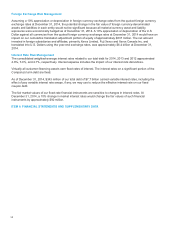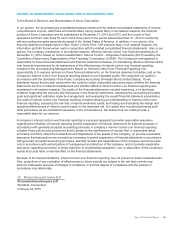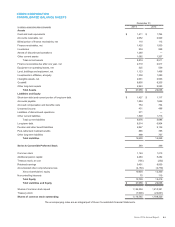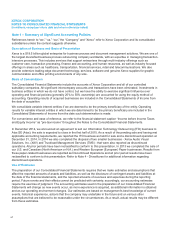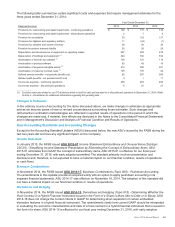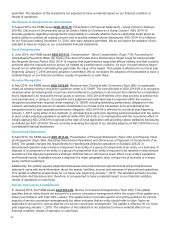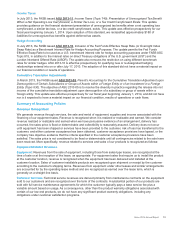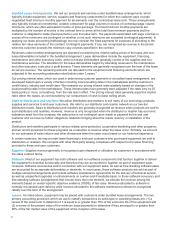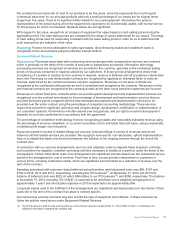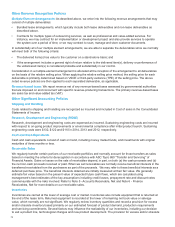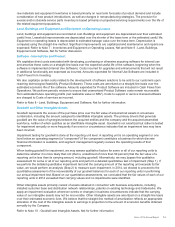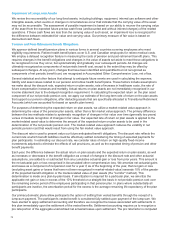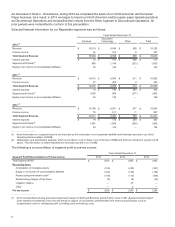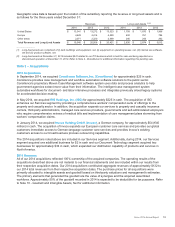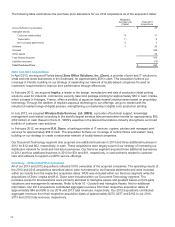Xerox 2014 Annual Report Download - page 84
Download and view the complete annual report
Please find page 84 of the 2014 Xerox annual report below. You can navigate through the pages in the report by either clicking on the pages listed below, or by using the keyword search tool below to find specific information within the annual report.
permitted. The adoption of this standard is not expected to have a material impact on our financial condition or
results of operations.
Disclosures of Going Concern Uncertainties
In August 2014, the FASB issued ASU 2014-15,Presentation of Financial Statements - Going Concern (Subtopic
205-40); Disclosure of Uncertainties about an Entity’s Ability to Continue as a Going Concern. ASU 2014-15
provides guidance regarding management's responsibility to evaluate whether there is substantial doubt about an
entity's ability to continue as a going concern and to provide related footnote disclosures. ASU 2014-15 is effective
for our fiscal year ending December 31, 2016, with early adoption permitted. We do not expect the adoption of this
standard to have an impact on our consolidated financial statements.
Stock Compensation
In June 2014, the FASB issued ASU 2014-12,Compensation - Stock Compensation (Topic 718): Accounting for
Share-Based Payments When the Terms of an Award Provide that a Performance Target Could be Achieved after
the Requisite Service Period. ASU 2014-12 requires that a performance target that affects vesting, and that could be
achieved after the requisite service period, be treated as a performance condition. As such, the performance target
should not be reflected in estimating the grant date fair value of the award. This update is effective for our fiscal year
beginning January 1, 2016 and early adoption is permitted. We do not expect the adoption of this standard to have a
material impact on our financial condition, results of operations or cash flows.
Revenue Recognition
In May 2014, the FASB issued ASU 2014-09,Revenue from Contracts with Customers (Topic 606), to supersede
nearly all existing revenue recognition guidance under U.S. GAAP. The core principle of ASU 2014-09 is to recognize
revenues when promised goods or services are transferred to customers in an amount that reflects the consideration
that is expected to be received for those goods or services. ASU 2014-09 defines a five step process to achieve this
core principle and, in doing so, it is possible more judgment and estimates may be required within the revenue
recognition process than required under existing U.S. GAAP, including identifying performance obligations in the
contract, estimating the amount of variable consideration to include in the transaction price and allocating the
transaction price to each separate performance obligation. ASU 2014-09 is effective for our fiscal year beginning
January 1, 2017 using either of two methods: (i) retrospective to each prior reporting period presented with the option
to elect certain practical expedients as defined within ASU 2014-09; or (ii) retrospective with the cumulative effect of
initially applying ASU 2014-09 recognized at the date of initial application and providing certain additional disclosures
as defined per ASU 2014-09. We are currently evaluating the impact of our pending adoption of ASU 2014-09 on our
consolidated financial statements.
Discontinued Operations
In April 2014, the FASB issued ASU 2014-08,Presentation of Financial Statements (Topic 205) and Property, Plant,
and Equipment (Topic 360): Reporting Discontinued Operations and Disclosures of Disposals of Components of an
Entity. The update changes the requirements for reporting discontinued operations in Subtopic 205-20. A
discontinued operation may include a component of an entity or a group of components of an entity, or a business. A
disposal of a component of an entity or a group of components of an entity is required to be reported in discontinued
operations if the disposal represents a strategic shift that has (or will have) a major effect on an entity’s operations
and financial results. Examples include a disposal of a major geographic area, a major line of business or a major
equity method investment.
Additionally, the update requires expanded disclosures about discontinued operations that will provide financial
statement users with more information about the assets, liabilities, income and expenses of discontinued operations.
This update is effective prospectively for our fiscal year beginning January 1, 2015. The standard primarily involves
presentation and disclosure and, therefore, is not expected to have a material impact on our financial condition,
results of operations or cash flows.
Service Concession Arrangements
In January 2014, the FASB issued ASU 2014-05,Service Concession Arrangements (Topic 853). This update
specifies that an entity should not account for a service concession arrangement within the scope of this update as a
lease in accordance with Topic 840, Leases. The update does not provide specific accounting guidance for various
aspects of service concession arrangements but rather indicates that an entity should refer to other Topics as
applicable to account for various aspects of a service concession arrangement. The update is effective for our fiscal
year beginning January 1, 2015. The adoption of this standard is not expected to have a material effect on our
financial condition, results of operation or cash flows.
69


